Posted by Anita on 05.07.07 5:41 PM
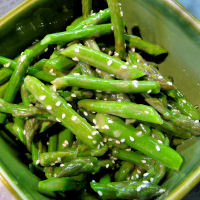 I’m slightly obsessed with my tattered copy of Big Bowl Noodles and Rice by Asian food guru Bruce Cost. It’s my first choice when I need a comforting stir-fry or noodle dish, especially when I’m in the mood for Eastern flavors without a lot of fuss. But last week, while staring down a bunch of asparagus and looking for a suitable stir-fry side-dish, I came across one recipe that, shockingly, I’d never tried.
I’m slightly obsessed with my tattered copy of Big Bowl Noodles and Rice by Asian food guru Bruce Cost. It’s my first choice when I need a comforting stir-fry or noodle dish, especially when I’m in the mood for Eastern flavors without a lot of fuss. But last week, while staring down a bunch of asparagus and looking for a suitable stir-fry side-dish, I came across one recipe that, shockingly, I’d never tried.
Like so many Big Bowl recipes, this salad manages to achieve a completely authentic flavor without any oddball ingredients. (Don’t get me wrong: I love the bottom shelf of my pantry, stocked with goodies from Uwajimaya and 99 Ranch, but sometimes even adventurous cooks don’t want another sticky bottle of imported exotica.) The simple dressing allows the natural beauty of perfectly fresh asparagus — one of my true springtime delights — to shine through, complementing and highlighting the fresh crispness without muddying flavors with overwhelming ingredients.
Asparagus Salad with Sesame Seeds
1 T sesame seeds
1 bunch (approximately 1 pound) fresh asparagus
2 tsp. rice-wine vinegar
3/4 tsp. red-wine vinegar
3/4 tsp. soy sauce or fish sauce
3/4 tsp. sugar
3/4 tsp. Dijon mustard
1 T fine peanut oil
2 tsp. sesame oil
In a small skillet, toast the sesame seeds until golden, shaking the pan so they don’t burn.
 Remove any woody ends of the asparagus, cut the stalks into 2-inch lengths. Parboil them in 6 cups of heavily salted water for 2 to 3 minutes, depending on their thickness. Drain and run under cold water to stop cooking. Dry thoroughly. (Once perfectly dry, the asparagus may be chilled, overnight, in a loosely covered container. If you leave any moisture, it will make the spears mushy.)
Remove any woody ends of the asparagus, cut the stalks into 2-inch lengths. Parboil them in 6 cups of heavily salted water for 2 to 3 minutes, depending on their thickness. Drain and run under cold water to stop cooking. Dry thoroughly. (Once perfectly dry, the asparagus may be chilled, overnight, in a loosely covered container. If you leave any moisture, it will make the spears mushy.)
Mix together the vinegars, soy or fish sauce, sugar, and mustard. Whisk in the oils, as you would for a vinaigrette. Toss the dressing with the asparagus, and sprinkle with the toasted sesame seeds.
cookbooks, cooking, other blogs, recipes
3 Comments »




Posted by Anita on 05.06.07 11:00 PM
 If you’ve spent any time on food blogs, I’m sure you know Barbara of Winos & Foodies — the creator of one of my favorite blog events, Hay Hay, It’s Donna Day. Barbara asked her food-blogging friends to participate in a new blog event called A Taste of Yellow by preparing a dish containing some type of yellow food. On May 16 — in honor of the Lance Armstrong Foundation’s LIVESTRONG Day — Barbara will post a roundup of the Taste of Yellow posts. She’s collected almost 30 so far!
If you’ve spent any time on food blogs, I’m sure you know Barbara of Winos & Foodies — the creator of one of my favorite blog events, Hay Hay, It’s Donna Day. Barbara asked her food-blogging friends to participate in a new blog event called A Taste of Yellow by preparing a dish containing some type of yellow food. On May 16 — in honor of the Lance Armstrong Foundation’s LIVESTRONG Day — Barbara will post a roundup of the Taste of Yellow posts. She’s collected almost 30 so far!
Our entry for A Taste of Yellow has languished in my “to try” file for a while, and I wish we’d made it sooner. It turned out to be so easy and tasty, it’s sure to become a standby in our house. In honor of Barbara’s New Zealand locale, we served the yellow potatoes alongside grilled lamb chops (in a yellow curry sauce, just to be double-sure we had the theme covered). Both the curry and the potato recipe came from the Vij’s cookbook, which you may remember from the gorgeous paneer dish we mentioned last month.
Turmeric offers many health-giving effects. The ginger-like rhizome has been used medicinally in traditional Asian and Indian practice for centuries. It acts as an anti-inflammatory and antibacterial agent, and its antioxidant properties have been shown to prevent free-radical damage that’s been linked to cancer. In laboratory tests, turmeric’s active ingredient has decreased symptoms of skin cancers, and reduced the incidence of chemically caused breast cancer in laboratory animals. Three current clinical trials at the US National Institutes of Health are targeting pancreatic cancer, multiple myeloma, and colorectal cancer using turmeric’s main compounds.
And, of course, it’s a gorgeous shade of yellow.
 Vij’s Turmeric Potatoes
Vij’s Turmeric Potatoes
1 pound yellow new potatoes
2 T canola oil
3/4 cup chopped onion (1/2 large onion)
1/2 tsp turmeric
1-1/2 tsp salt
1/4 tsp cayenne pepper
2 T water
3 oz baby spinach
Wash and scrub the potatoes, but do not peel them. Cut each potato in 1/4-inch rounds using a food processor or mandoline.
Heat oil in a heavy frying pan on medium heat for 1 minute. Add onions and saute for 5 minutes, or until golden. Add turmeric, salt, and cayenne; stir well and cook for 1 minute.
Add potatoes and water, and bring to a light boil. Gently stir the potatoes. Reduce heat to low, cover, and cook for about 10 minutes. If the potatoes stick or begin to burn, add another 2 T water. Gently stir the potatoes again. Cover and cook another 4 minutes, or until potatoes are almost done, but not too soft. Add the spinach, cover, and cook for 1 minute longer.
cookbooks, cooking, other blogs, recipes
6 Comments »




Posted by Cameron on 04.18.07 9:47 PM
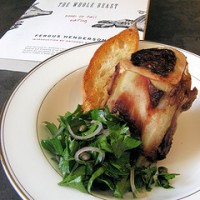 “I got nasty habits, I take tea at three
“I got nasty habits, I take tea at three
Yes and the meat I eat for dinner
Must be hung up for a week”
–“Live With Me,” The Rolling Stones
Quick flashback to five years ago, just before we became legally married with dinner. We relate our honeymoon plans to friends and acquaintances and are met with raised eyebrows and a single repeated question:
“You’re going to England for two weeks? What are you going to eat?”
Everything that we could fit in, thank you very much, and the list was longer than we’d have time or money for. Every Real Ale pub within reach of the Underground. Boxwood Cafe. Pork and stilton breakfast sandwiches from the Borough Market, washed down with Monmouth Coffee. Cheese from Neals Yard Dairy. English breakfast, bangers please. Eton Mess. Branston Pickle. Chip shops. Eccles cakes. Pret a Manger. McVitties. Packaged meals from London groceries as good or better than you could make with fresh ingredients.
 But the meal that I was not-so-secretly looking forward to the most was dinner at St. John Bar and Restaurant. It was food that (at the time) I could only find in England. Every possible part of some ridiculously tasty animal prepared and served practically unadorned. Anita still wakes with a start from dreams of Middlewhite pork. Here I found what I adore about English cuisine: naked love for animal fat, roasted flesh, organ meats, connective tissue, and wild things from the hunt. Pig tails, venison, game birds, sliced roast beef, Yorkshire pudding.
But the meal that I was not-so-secretly looking forward to the most was dinner at St. John Bar and Restaurant. It was food that (at the time) I could only find in England. Every possible part of some ridiculously tasty animal prepared and served practically unadorned. Anita still wakes with a start from dreams of Middlewhite pork. Here I found what I adore about English cuisine: naked love for animal fat, roasted flesh, organ meats, connective tissue, and wild things from the hunt. Pig tails, venison, game birds, sliced roast beef, Yorkshire pudding.
And beef marrow. Have mercy, the beef marrow.
Roast Bone Marrow and Parsley Salad
from The Whole Beast: Nose to Tail Eating, by Fergus Henderson
(note: this recipe captures just a bit of Chef Henderson’s calm, dry voice and humor. The actual cookbook is as entertaining to read as it is to use. Plus, who else is going to tell you how to deep-fry lamb’s brains?)
– serves four
twelve 3-inch pieces of veal marrowbone
a healthy bunch of flat-leaf parsely, leaves picked from the stems
2 shallots, peeled and very thinly sliced
1 modest handful of capers (extra-fine if possible)
Dressing:
juice of 1 lemon
extra-virgin olive oil
a pinch of sea salt and freshly ground pepper
a good supply of toast
coarse salt
Put the marrowbone pieces in an ovenproof frying pan and place in a hot 450 degree (F) oven. The roasting process should take about 20 minutes depending on the thickness of the bone. You are looking for the marrow to be loose and giving, but not melted away, which it will do if left too long (traditionally the ends would be covered to prevent any seepage, but I like the coloring and crispness at the ends).
Lightly chop your parsley, just enough to discipline it, mix it with the shallots and capers, and at the last moment, dress the salad.
Here is a dish that should not be completely seasoned before leaving the kitchen, rendering a last-minute seasoning unnecessary by the actual eater; this, especially in the case of coarse sea salt, gives texture and uplift at the moment of eating. My approach is to scrape the marrow from the bone onto the toast and season with coarse sea salt. Then a pinch of parsley salad on top of this and eat. Of course once you have your pile of bones, salad, toast, and salt it is diner’s choice.
English food is not a joke because nose to tail eating is serious business.
This post is part of the Fish & Quips event hosted by Becks & Posh, in honor of St. George’s Day.
cookbooks, cooking, holidays & occasions, meat, other blogs, recipes, travel
9 Comments »




Posted by Cameron on 04.10.07 4:31 PM
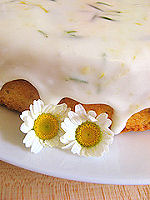 Last Saturday, we enjoyed a pre-Easter dinner with our friends DPaul and Sean and Anita’s mom, Toni. Anita has already described the first course; my contribution was Cornmeal Rosemary Cake with Lemon Glaze from one of our two Tom Douglas cookbooks, Tom’s Big Dinners.
Last Saturday, we enjoyed a pre-Easter dinner with our friends DPaul and Sean and Anita’s mom, Toni. Anita has already described the first course; my contribution was Cornmeal Rosemary Cake with Lemon Glaze from one of our two Tom Douglas cookbooks, Tom’s Big Dinners.
I’m not sure exactly why I ended up making it, as I’m not much of a baker. Anita is usually the head chef in our kitchen, but she was called away to help with the transportation of Sean and DPaul’s new (and absolutely adorable, but indisposed) family member. We needed to get cracking on dinner, but when Toni–who is an accomplished baker–asked to be put to work, I pointed her at the soup, not the cake. Go figure.
The batter assembly went smoothly. Or at least I thought it did until I realized that I had used rough, coarsely ground cornmeal instead of the medium-grind called for by the recipe. I pinched the bridge of my nose and rehearsed stand-up material to explain the…er…crunchy cake. “So rustic, isn’t it?” I imagined myself saying through my best Joy of Cooking smile. “Here, have another large glass of whiskey to wash that down. It’s a family tradition.”
Then, after fifteen minutes of baking, I noticed that while I had set the oven to 350 degrees, the thermometer inside read 325. Great. I turned up the heat.
The baking time recommended by the recipe came and went and I hovered at the oven window. The top started to brown and the cake tester came out clean, but when the cake was lying unmolded and upside down, it was obviously still mushy in the middle. Rummaging through our generous assortment of nonstick cake pans, I said a silent little prayer of thanks for my lovely, brainy wife and her talent for collecting cookware.
I re-panned the cake and shoveled it back in the oven, setting the timer in five-minute increments and wondering how the hell I would know when the damn thing was done. Out of desperation, I fell back on my grill-fu and started poking the cake with my (scrupulously clean) fingers, comparing the center with the edges, which I figured were sufficiently cooked.
Eureka! The top was much browner than I would have dared let it go otherwise, but eventually the cake stopped feeling like a waterbed. Cooled and unmolded, it actually looked edible–after Anita helped re-assemble the chunks that had stuck to the non-stick pan.
But I had the baker’s ace up my sleeve, the magical stuff that hides an epic poem’s worth of sins. I generously brushed on a Meyer lemon syrup (fruits from our tree!) and then took great comfort in watching my missteps and misgivings disappear beneath a dense white robe of sugary glaze speckled with rosemary leaves and lemon zest.
Didn’t taste bad, either. No whiskey necessary.
baking, cookbooks, dessert, family, holidays & occasions
5 Comments »




Posted by Anita on 04.05.07 7:45 AM
 You’d think that after torturing myself for three months, poring over recipes that I couldn’t begin to attempt without a proper kitchen, I’d be able to choose one or two candidates from a single cookbook. But there were so many delectable-sounding recipes in the copy of Vij’s: Elegant & Inspired Indian Cuisine that my sister gave me for Christmas, I finally had to force myself to pick a couple at random.
You’d think that after torturing myself for three months, poring over recipes that I couldn’t begin to attempt without a proper kitchen, I’d be able to choose one or two candidates from a single cookbook. But there were so many delectable-sounding recipes in the copy of Vij’s: Elegant & Inspired Indian Cuisine that my sister gave me for Christmas, I finally had to force myself to pick a couple at random.
After much deliberation, I set my sights on a buttermilk curry, which Vij admits “from a visual point of view … won’t win any prizes”. Hey, if a dish is ugly enough to require forewarning, and it still makes the cut for inclusion in your restaurant’s signature cookbook, it must be pretty tasty. And indeed it was: Scented with cloves and cardamom, and thickened with mashed potato, the comforting stew-like dish reminded me of a Thai massaman curry. (No big surprises there, as the Thai dish was originally brought over from either Persia or the Subcontinent, depending on who you ask.)
True to Vij’s disclaimer, it looked for all the world like the stuff you’d scrape off the top of a simmering stock, an unappetizing mass of curdled dairy and greying meat. But inside each bland-looking cube of meat lurked a secret: Vivid, almost violet-hued shreds of beef, meltingly tender and softly perfumed with spices. The sauce, too, came together into something a bit less rotten-looking in the last few minutes of simmering. Although it never turned into the proverbial swan, I suppose I could admit this curry was a slightly less-ugly duckling on the plate than it had been two hours earlier in the pot.
 I don’t think I consciously picked a gorgeous dish for my second recipe, but that’s certainly how Sauteed Greens and Paneer turned out. I hope you won’t think I’m being immodest when I say it looked almost as good on the plate as it did in the cookbook photo; I mean it as a compliment to the recipe, not to my (admittedly weak) food-styling skills. Despite being listed in the book’s appetizers chapter, this savory melange proved plenty rich enough to serve as a very satisfying vegetarian entree, or to divvy up into smaller portions for a true starter.
I don’t think I consciously picked a gorgeous dish for my second recipe, but that’s certainly how Sauteed Greens and Paneer turned out. I hope you won’t think I’m being immodest when I say it looked almost as good on the plate as it did in the cookbook photo; I mean it as a compliment to the recipe, not to my (admittedly weak) food-styling skills. Despite being listed in the book’s appetizers chapter, this savory melange proved plenty rich enough to serve as a very satisfying vegetarian entree, or to divvy up into smaller portions for a true starter.
I’ve been lucky enough to eat at Vij’s famed Vancouver restaurant — and its take-away branch next door, Rangoli — on trips to Vancouver a few years back. Both of these recipes felt true to the flavors and presentations I remember enjoying there, modern Canadian riffs on traditional Indian flavors that somehow managed to avoid the caricature-like glitches that mar most fusion cuisine. Both restaurants seem like the kind of places where we’d eat a lot if we lived nearby, or even if we visited more often. Since a trip to Vancouver isn’t be in the cards for a while, I’m looking forward to delving deeper into this gorgeous collection of recipes. But on the strength of these two dishes alone, this book’s already a keeper.
Please note: The recipes below differ slightly from the published versions, mostly because I scaled them to match the quantities of raw ingredients I had on hand. I also clarified some instructions that I found confusing on the first read-through.
Sauteed Greens with Paneer
14 whole raw unsalted cashews
1/2 pound raw spinach
1/2 pound rapini (aka broccoli raab, choi sum, etc.)
1/4 cup vegetable oil
1-1/2 tsp. cumin seeds
1 cup pureed tomatoes (about 2 medium)
2 tsp. ground black mustard seeds
1/4 tsp ground turmeric
1 tsp. salt
3/4 tsp. cayenne pepper
1 cup water
4 oz. coconut milk, stirred
6 oz. paneer, brought to room temperature
Toast the cashews in the oven (3 minutes at 375, stir, 3 more minutes) or on the stovetop; let cool.
Cut the tougher stems off the spinach and the rapini. Heat oil in large frying pan for 1 minute. Add cumin seeds, stir and allow to sizzle for 30 to 45 seconds. Add tomato puree, mustard seeds, turmeric, salt, and cayenne. Stir and reduce heat to medium-low, then cover and cook for 5 minutes. Remove the lid and stir. The top of the sauce should glisten with oil; if it does not, cook uncovered another 1-2 minutes.
Stir in water and increase heat to medium-high. Bring to a boil, then reduce heat to a steady simmer, and cook for 5 to 8 minutes, until sauce thickens. Add coconut milk, and continue cooking until the mixture starts to simmer briskly. Add greens and cook for 2 minutes or until well wilted, stirring regularly.
Slice the paneer into 4 pieces the long way, then slice each half again to make vaguely square-ish blocks. To serve 2 as a vegetarian entree, place half of the slices in each bowl; to serve 4 as an appetizer, divide among 4 bowls. Using a tongs, place the greens on top of the paneer slices, leaving the corners peeking out. Spoon the curry sauce over and around the greens, again taking care to leave part of the paneer visible. Top the greens with the cashews, and serve.
Buttermilk Curry
3 cups buttermilk
3/4 cup water
2 pounds lamb or beef stew meat, in 2-inch cubes
1-1/2 tsp. coriander seeds
1/3 cup vegetable oil
1T cumin seeds
2T chopped garlic
10-15 2-inch pieces of dried red chiles
10 cloves
1 tsp. cardamom seeds (not pods)
2 tsp. salt
1 medium potato, peeled, boiled, and mashed
Pour buttermilk into a large mixing bowl, and add the meat. Mix well. If there is not sufficient liquid to cover the meat, add enough of the water to do so, and mix again. Cover the bowl with plastic wrap, and refrigerate 6 hours, or overnight.
Lightly pound the coriander in a mortar to break the seeds in half. Heat oil in a pot over medium heat for 1 minute. Add cumin seeds and cook until they pop (30-45 seconds). Add garlic and saute for 5 minutes, or until golden. Add remaining spices and salt; stir well and cook 3-4 minutes.
Add marinated meat, buttermilk, and remaining water. Stir continuously and bring to a boil. Reduce heat to medium-low, cover, and cook for about 1 hour. Remove the lid and stir in the mashed potato. Cover the pot again, and cook for another hour, until the meat is tender.
Remove the cloves before serving, or warn your guests to expect them. Serve over rice.
cookbooks, cooking
4 Comments »




Posted by Anita on 03.28.07 7:55 PM
 As I told a friend today in email, “finished” is perhaps too strong a word for the current state of the kitchen remodel, but that didn’t stop us from moving back upstairs over the weekend. And since everyone — and I do mean everyone, from my boss to the craftsman who created our gorgeous countertops — has asked: The first thing we cooked in our new kitchen was …pan-seared chicken.
As I told a friend today in email, “finished” is perhaps too strong a word for the current state of the kitchen remodel, but that didn’t stop us from moving back upstairs over the weekend. And since everyone — and I do mean everyone, from my boss to the craftsman who created our gorgeous countertops — has asked: The first thing we cooked in our new kitchen was …pan-seared chicken.
Boring, you say? Delicious, says me. And, more to the point, a dish that would have been nearly impossible to create in our temporary kitchen. But with a vent hood, a powerful stove, and an oven that comfortably holds an entire skillet, it was as easy as one, two, three.
One: Cam cut a Prather Ranch heritage-breed chicken into parts, seared its duck-like skin on the stovetop, and then slid it into the oven to finish cooking through.
Two: I sauteed some broccoli di ciccio in a pan with peppery olive oil, added a bit of garlic to sweat, and combined it with some orecchiete and parmesan.
Three: Cam removed the now-roasted chicken from the pan, sauteed some quartered mushrooms in the rendered chicken fat, added a bit of wine, and called it sauce.
Damn. Having a good kitchen makes these kind of simple meals a real pleasure. I’d almost forgotten how much fun it is to make something by heart. Sure, it’s been a challenge — and I mean that in the best way — to get delicious stuff on the table with only a toaster oven and a porta-burner, but it’s so nice to finally be living and cooking in this space, this project that’s been taking up the vast majority of our energies for ages.
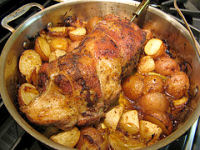 Over the last couple of days, we’ve celebrated many other “firsts.” Our inaugural breakfast included Fatted Calf bacon, perfectly fried eggs, and toasted Acme pain de mie. We made our first old favorite, the Zuni Cafe mock porchetta with roasted roots, in our new oven. And for our first new-to-us dish, I turned to a recipe that had been calling my name for weeks: Spaghetti al’ Limone from Avenue Food, which I’d printed out and squirreled away with the express idea of cooking it as soon as I could boil a pot full of water without waiting two hours.
Over the last couple of days, we’ve celebrated many other “firsts.” Our inaugural breakfast included Fatted Calf bacon, perfectly fried eggs, and toasted Acme pain de mie. We made our first old favorite, the Zuni Cafe mock porchetta with roasted roots, in our new oven. And for our first new-to-us dish, I turned to a recipe that had been calling my name for weeks: Spaghetti al’ Limone from Avenue Food, which I’d printed out and squirreled away with the express idea of cooking it as soon as I could boil a pot full of water without waiting two hours.
Last night, we made our first braise, and our first meal from our favorite cookbook — a Moroccan-esque chicken with preserved lemons and olives. Stumped for a side dish, I concocted the kitchen’s first new recipe, a jumble of veggies from this weekend’s farmers market trek and a few pantry staples. Like everything else we’ve cooked this week, it was nothing extraordinary. But the joy of making it, and the pleasure of its first-ness, were enough to keep me smiling even through the dishwashing.
 Amid all this giddy cooking, it’s easy to forget that we still have plenty of items on the punch list — including dealing with the joy(!) of knob-free doors and drawers until sometime around Easter week, when our re-made cabinet doors are due to arrive. In the meantime, we’ve got a lot of great dinners planned, a lot more hoarded recipes to try. And we’re amusing ourselves by slowly coming to grips with the fact that it’s all finally REAL. We can’t wait to share some photos (and some more meals) with you soon.
Amid all this giddy cooking, it’s easy to forget that we still have plenty of items on the punch list — including dealing with the joy(!) of knob-free doors and drawers until sometime around Easter week, when our re-made cabinet doors are due to arrive. In the meantime, we’ve got a lot of great dinners planned, a lot more hoarded recipes to try. And we’re amusing ourselves by slowly coming to grips with the fact that it’s all finally REAL. We can’t wait to share some photos (and some more meals) with you soon.
The “First” Salad
1 cup (about 1/2 can) drained garbanzo beans
1 small cucumber, diced (peeled if thick-skinned)
1 small heirloom tomato, seeded and diced (about 1/2 cup)
1/2 tsp. whole Mexican oregano, crumbled
1-1/2 tsp. chopped flat-leaf parsley
2 stalks green garlic, white and light-green parts, sliced thin
1T (or to taste) rich olive oil
juice of 1/2 Meyer lemon (about 1T)
salt and pepper, to taste
cookbooks, cooking, kitchen, recipes
15 Comments »




Posted by Anita on 02.19.07 6:06 PM
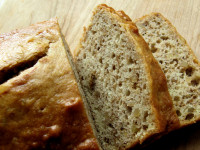 Every cook has those recipes that she considers so perfect that she won’t even entertain the idea of trying another variation. In our house, for example, there is no meatloaf but our meatloaf. I’m so set in my ways that not only will I not try new meatloaf recipes, I rarely even order meatloaf at restaurants.
Every cook has those recipes that she considers so perfect that she won’t even entertain the idea of trying another variation. In our house, for example, there is no meatloaf but our meatloaf. I’m so set in my ways that not only will I not try new meatloaf recipes, I rarely even order meatloaf at restaurants.
So when, during a long-overdue freezer cleanout, Mom and I discovered a stash of bananas, and then another stash, we knew it was time for another of those “don’t bother with another recipe” recipes: Banana bread.
Now, with all modesty, I’m not the only one who loves this stuff. It’s a recipe so wonderful that it was printed — albeit with some non-fatal editorial alterations — by Cooking Light many years ago, and apparently remains a reader favorite. (I cringed in anticipation when I clicked on the reader comments link, and was amazed to see that everyone likes this recipe as much as we do. Whew!)
Here’s my introduction from the original issue:
My mom, Toni, has been making this banana bread for what seems like forever. We’re nuts about all kinds of bread, and this is a family favorite — even the dog loves it. While it may seem odd not to add spices, the pure banana flavor is what makes it so delicious.
You can find the tinkered-with version on Cooking Light’s site, but here’s the original, which isn’t really much higher in fat:
Toni’s Banana Bread
1-3/4 cups flour
3/4 tsp. baking soda
1-1/4 tsp. cream of tartar
1/2 tsp. salt
1/3 cup vegetable oil
2 eggs, lightly beaten
2 medium super-ripe bananas (about 1 cup)
scant 2/3 cup sugar
1/2 cup chopped walnuts (optional)
Preheat oven to 350F, and butter an 8×4 loaf pan (or two 7×3 pans for tea-size loaves).
Whisk dry ingredients together in a large mixing bowl, and set aside.
Put the remaining ingredients (except optional nuts)Â in a blender and puree until smooth. Pour the banana puree over the dry ingredients, and fold lightly — adding nuts, if using –Â with a rubber spatula, just until combined; do not overmix.
Pour batter into the buttered loaf pan. Bake for 40 minutes or until a cake tester inserted in the center comes out clean, but do not overbake. Cool for 10 minutes in the pan, then remove from pan and cool completely on a wire rack.
baking, family, magazines, recipes
5 Comments »




Posted by Anita on 12.11.06 7:00 AM
 No need to book a plane ticket, or shop for an expensive hotel room. As part of this year’s Menu for Hope food blogger charity raffle, “Married …with Dinner” will send one lucky winner everything she needs to take a foodie’s tour of the San Francisco Bay Area from the comfort of her own kitchen!
No need to book a plane ticket, or shop for an expensive hotel room. As part of this year’s Menu for Hope food blogger charity raffle, “Married …with Dinner” will send one lucky winner everything she needs to take a foodie’s tour of the San Francisco Bay Area from the comfort of her own kitchen!
Your “Armchair Food Tour of the San Francisco Bay Area” includes taste-tempting treats from four Northern California counties.
The first stop on our tour is San Francisco, where we pick up:
– a copy of the Ferry Plaza Farmers Market cookbook
– a 4.25-oz holiday ornament filled with assorted Ghirardelli chocolates
We cross the bay to Berkeley, and sample:
– a 3/4-pound bag of Peet’s Coffee limited-edition Holiday Blend
– a 13.5-oz. jar of Scharffen Berger Pure Dark Ganache Chocolate Sauce
– an 8-oz. pot of June Taylor Blackberry Conserve
Then over the Golden Gate Bridge to the Wine Country, where we find:
– a 1-pound bag of Rancho Gordo “Ojo de Tigre” heirloom beans
– a 12.5-oz. bottle of Sonoma Syrup Company’s Eureka Lemon simple syrup
The total value of this gourmet gift basket is more than $75! Your winning bid includes FREE shipping to any address in the continental US. [If you live beyond the 48 states, we’ll foot bill for shipping up to $25. Please contact chef (at) marriedwithdinner (dot) com and we’ll estimate shipping charges for you, if you’re interested.]
This raffle prize is CODE UW-34. (Write that down… you’ll need it later.)
Enough of all that!! How do you qualify to win this glorious prize? It’s SOOO simple:

- Check out the other cool items available on Becks & Posh, and Chez Pim. (We know you want OUR prize, but you might want to bid on others, too … you generous foodie, you.)
- Go to the donation page for Menu for Hope III. This year, funds raised will go to support the United Nation’s World Food Programme.
-
Make a donation! Each $10 pledge will give you one virtual raffle ticket toward a prize of your choice. Please specify which prize or prizes you’d like in the ‘Personal Message’ section in the donation form when confirming your donation. Don’t forget to mention how many tickets you want to allot per prize, and please use the prize code — for example, a donation of $50 can buy 2 tickets for UW-01 and 3 for UW-34 (our prize, natch).
- If your company matches your charity donations, please remember to check the appropriate box on your submission and fill in the information so Menu for Hope can claim the corporate match.
- Please also check the box that allows the contest gurus to see your email address so that they can contact you in case you win. Your email address will not be shared with anyone.
- Check back on Chez Pim on January 15, when Pim will announce the result of the entire raffle. (We’ll also announce the winner of the Armchair Food Tour here.)
Good luck to all! And thanks for helping support a worthy cause.
cookbooks, other blogs, shopping
5 Comments »




Posted by Anita on 12.03.06 9:02 PM
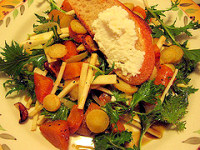 Over on My Life as a Reluctant Housewife, Gabriella invited us to share favorite autumn salads. When I read her post, my first thought was of Autumn Vegetables with Goat Ricotta, a complicated concoction I’d seen in the Babbo Cookbook featuring an array of fall veggies tossed with prickly lettuces and garnished with a both a dressing and two flavored oils.
Over on My Life as a Reluctant Housewife, Gabriella invited us to share favorite autumn salads. When I read her post, my first thought was of Autumn Vegetables with Goat Ricotta, a complicated concoction I’d seen in the Babbo Cookbook featuring an array of fall veggies tossed with prickly lettuces and garnished with a both a dressing and two flavored oils.
We hunted the farmers’ market for sunchokes, celery root, parsnips, and golden beets (to substitute for the squash neither of us likes), then tackled all of the mise en place — making sage oil, braising the beets, and roasting the sunchoke slices with cumin — over the course of a few evenings. Imagine our letdown when we tasted it, and found the flavors rather blah.
It wasn’t a total loss: The cumin-roasted sunchokes are good enough that I’d make them separately as a side dish. And crostini smeared with Cowgirl Creamery sheep’s ricotta… what’s not to like? But this is a tease of a dish: A ton of work for relatively little payoff; a gorgeous, show-stopping plate with no soul.
The next night, I was casting about for a way to use a tiny smidge of guanciale from Fatted Calf, too small to be used in a main course, but too large to waste. Flipping through my recipe clippings, I noticed an appealing salad from the September issue of Gourmet. Substituting pecorino for the ricotta salata, and replacing pancetta with guanciale, I actually had everything on hand that I needed to make this delicious autumn salad… one that’s hearty enough that you’ll enjoy eating it on a chilly evening, and simple enough to make on a whim.
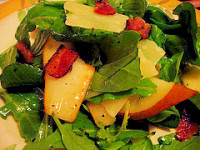 Pear and Arugula Salad
Pear and Arugula Salad
1 T Champagne vinegar
1 T honey
1-1/2 tsp. lemon juice
salt & pepper, to taste
3 T olive oil
—
2 oz thinly sliced guanciale
1 T olive oil
1 firm-ripe pear
4 cups baby arugula
3 oz. pecorino romano, thinly shaved
Whisk together vinegar, honey, lemon juice, salt, and pepper in a salad bowl. Add oil in a slow stream, whisking until well emulsified.
Cook guanciale in a 10-inch heavy skillet over moderate heat, turning frequently, until just crisp. Transfer to paper towels to drain, and crumble into bite-size pieces.
Halve the pear lengthwise, core it, and cut lengthwise into 1/4-inch-thick slices. Add pears to dressing along with arugula, cheese, and guanciale, tossing to coat.
Serves 4.
cookbooks, magazines, other blogs, recipes
1 Comment »




Posted by Cameron on 11.30.06 11:56 PM
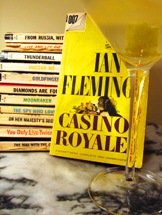
“When I’m–er–concentrating, I never have more than one drink before dinner. But I do like that one to be large and very strong and very cold and very well-made.”
–James Bond, Casino Royale by Ian Fleming
Was ever a character from popular literature more poorly served by Hollywood than James Bond? We all know the silver screen buffoonery: arch, cartoonish cardboard cutouts with sapphire blue eyes. Hit the tape marks and luxuriate in the JiggleVision. Dress like a peacock, shake the gadgets. Secret agent? Bah. This is a man so monomaniacal in his habits that even his enemies know his drink preference.
But on the page, Ian Fleming’s international spy is a different man. He prefers a low profile. He is thoughtful and specific, driven by both personal inclination and professional urgency. He is a hopeless romantic and desperately human. Over the course of the original thirteen novels and a few short stories, Bond falls deeply in love, again and again, in the face of brutal heartbreak. He takes great pains to remain anonymous and alive in a dangerous trade, and he is intimately, passionately connected with the day-to-day business of living.
“You must forgive me,” he said. “I take a ridiculous pleasure in what I eat and drink. It comes partly from being a bachelor, but mostly from a habit of taking a lot of trouble over details. It’s very pernickety and old-maidish really, but then when I’m working I generally have to eat my meals alone and it makes them more interesting when one takes trouble.”
“Shaken, not stirred,” marketing-friendly bull***t be damned. Bond drinks whatever is appropriate, local, and good. In Turkey, it’s Kavaklidere, “a rich coarse burgundy like any other Balkan wine”. In the Caribbean: gin, tonic and lime (you can take the Boy out of the Empire…). Champagne? Just watch the man go. And when the vodka comes out, our man James drops pepper on top, for practical and aesthetic reasons:
‘It’s a trick the Russians taught me that time you attached me to the Embassy in Moscow,’ apologized Bond. ‘There’s often quite a lot of fusel oil on the surface of this stuff –at least there used to be when it was badly distilled. Poisonous. In Russia, where you get a lot of bath-tub liquor, it’s an understood thing to sprinkle a little pepper in your glass. It takes the fusel oil to the bottom. I got to like the taste and now it’s a habit. But I shouldn’t have insulted the club Wolfschmidt,’ he added with a grin.
But there’s only one drink that Bond invented, and it’s not the one you might think. The medium-dry vodka martini may have launched a thousand ships, but the Vesper, introduced in Casino Royale, is the original–really, the only–Bond drink. Not surprisingly, it’s a much more interesting cocktail:
“A dry Martini,” he said. “One. In a deep champagne goblet.”
“Oui, Monseiur.”
“Just a moment. Three measures of Gordon’s, one of vodka, half a measure of Kina Lillet. Shake it very well until it’s ice-cold, then add a large thin slice of lemon-peel. Got it?”
In The Book of Bond, Kingsley Amis argues that the mixture is a mistake, as that quantity of Kina Lillet would have made the cocktail undrinkably bitter. We will never know for sure, as the formula of Lillet was changed in 1986. Happily, the new Lillet works like a charm.
Made with one “measure” equaling one ounce, the Vesper is indeed a large, strong, cold cocktail. The vodka takes the edge off the gin and contributes a bit of sweetness which is reinforced by the Lillet and the lemon.
“This drink’s my own invention. I’m going to patent it when I can think of a good name.”
As might be expected, James can only find a bad one. This drink’s name comes from Vesper Lynd, a female spy who Bond initially ignores but then falls in love with. Vesper turns out to be a double-agent working for both the Russians and the British while in France. It’s a combination that echoes the ingredients of the cocktail that eventually bears her name: vodka, gin, and vermouth.
The Vesper
3 ounces gin
1 ounce vodka
1/2 ounce Lillet
Shake with ice and strain into a cocktail glass (or champagne coupe, if you have one). Garnish with a large, thin slice of lemon peel. Bet large. Tip the chef de partie. Flirt with Moneypenny. Get out before they use the laser.
Drink of the Week, drinks, literary, recipes
10 Comments »




 I’m slightly obsessed with my tattered copy of Big Bowl Noodles and Rice by Asian food guru Bruce Cost. It’s my first choice when I need a comforting stir-fry or noodle dish, especially when I’m in the mood for Eastern flavors without a lot of fuss. But last week, while staring down a bunch of asparagus and looking for a suitable stir-fry side-dish, I came across one recipe that, shockingly, I’d never tried.
I’m slightly obsessed with my tattered copy of Big Bowl Noodles and Rice by Asian food guru Bruce Cost. It’s my first choice when I need a comforting stir-fry or noodle dish, especially when I’m in the mood for Eastern flavors without a lot of fuss. But last week, while staring down a bunch of asparagus and looking for a suitable stir-fry side-dish, I came across one recipe that, shockingly, I’d never tried. Remove any woody ends of the asparagus, cut the stalks into 2-inch lengths. Parboil them in 6 cups of heavily salted water for 2 to 3 minutes, depending on their thickness. Drain and run under cold water to stop cooking. Dry thoroughly. (Once perfectly dry, the asparagus may be chilled, overnight, in a loosely covered container. If you leave any moisture, it will make the spears mushy.)
Remove any woody ends of the asparagus, cut the stalks into 2-inch lengths. Parboil them in 6 cups of heavily salted water for 2 to 3 minutes, depending on their thickness. Drain and run under cold water to stop cooking. Dry thoroughly. (Once perfectly dry, the asparagus may be chilled, overnight, in a loosely covered container. If you leave any moisture, it will make the spears mushy.)



 If you’ve spent any time on food blogs, I’m sure you know
If you’ve spent any time on food blogs, I’m sure you know  Vij’s Turmeric Potatoes
Vij’s Turmeric Potatoes “I got nasty habits, I take tea at three
“I got nasty habits, I take tea at three But the meal that I was not-so-secretly looking forward to the most was dinner at
But the meal that I was not-so-secretly looking forward to the most was dinner at  Last Saturday, we enjoyed a pre-Easter dinner with our friends
Last Saturday, we enjoyed a pre-Easter dinner with our friends  You’d think that after torturing myself for three months, poring over recipes that I couldn’t begin to attempt without a proper kitchen, I’d be able to choose one or two candidates from a single cookbook. But there were so many delectable-sounding recipes in the copy of
You’d think that after torturing myself for three months, poring over recipes that I couldn’t begin to attempt without a proper kitchen, I’d be able to choose one or two candidates from a single cookbook. But there were so many delectable-sounding recipes in the copy of  I don’t think I consciously picked a gorgeous dish for my second recipe, but that’s certainly how Sauteed Greens and Paneer turned out. I hope you won’t think I’m being immodest when I say it looked almost as good
I don’t think I consciously picked a gorgeous dish for my second recipe, but that’s certainly how Sauteed Greens and Paneer turned out. I hope you won’t think I’m being immodest when I say it looked almost as good  As I told a
As I told a  Over the last couple of days, we’ve celebrated many other “firsts.” Our inaugural breakfast included Fatted Calf bacon, perfectly fried eggs, and toasted Acme
Over the last couple of days, we’ve celebrated many other “firsts.” Our inaugural breakfast included Fatted Calf bacon, perfectly fried eggs, and toasted Acme  Amid all this giddy cooking, it’s easy to forget that we still have plenty of items on the punch list — including dealing with the joy(!) of knob-free doors and drawers until sometime around Easter week, when our re-made cabinet doors are due to arrive. In the meantime, we’ve got a lot of great dinners planned, a lot more hoarded recipes to try. And we’re amusing ourselves by slowly coming to grips with the fact that it’s all finally REAL. We can’t wait to share some photos (and some more meals) with you soon.
Amid all this giddy cooking, it’s easy to forget that we still have plenty of items on the punch list — including dealing with the joy(!) of knob-free doors and drawers until sometime around Easter week, when our re-made cabinet doors are due to arrive. In the meantime, we’ve got a lot of great dinners planned, a lot more hoarded recipes to try. And we’re amusing ourselves by slowly coming to grips with the fact that it’s all finally REAL. We can’t wait to share some photos (and some more meals) with you soon. Every cook has those recipes that she considers so perfect that she won’t even entertain the idea of trying another variation. In our house, for example, there is no meatloaf but our meatloaf. I’m so set in my ways that not only will I not try new meatloaf recipes, I rarely even order meatloaf at restaurants.
Every cook has those recipes that she considers so perfect that she won’t even entertain the idea of trying another variation. In our house, for example, there is no meatloaf but our meatloaf. I’m so set in my ways that not only will I not try new meatloaf recipes, I rarely even order meatloaf at restaurants. No need to book a plane ticket, or shop for an expensive hotel room. As part of this year’s
No need to book a plane ticket, or shop for an expensive hotel room. As part of this year’s 
 Over on
Over on  Pear and Arugula Salad
Pear and Arugula Salad